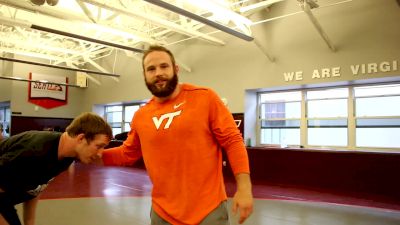Why You're Probably Not Drilling Outside Steps Enough
Why You're Probably Not Drilling Outside Steps Enough
An outside step single leg is one of the most important wrestling techniques that we ARE NOT teaching enough in this country.
Unlock this article, live events, and more with a subscription!
Already a subscriber? Log In
Over the course of the last 15 years of teaching, coaching, and traveling for this sport, one of the things that makes me scratch my head the most about wrestling in this country is the fact that more coaches are not teaching and reinforcing an outside step single leg. How much is this overlooked? Watch the video above.
Ty Walz is one of the best wrestlers in the country, and in the video above he begins it by referring to an outside step as a move that he's been “adding recently.”
That blows my mind.
How can it be that a U23 World medalist is only starting to add an outside step to his repertoire in June of 2019? It’s certainly not Ty Walz's fault. I blame the U.S.’s system of teaching leg attacks. In the video above, Walz refers to the fact that for him “normally everything is knee over toe penetration step,” and that he started to change the way that he drills or at least added to it in order to stay more athletic.
So why don’t we learn this magical wrestling move on our first day on a wrestling mat? The answer can get convoluted, but I will try to give you my most educated guess, and give you some pros and cons to the technique along the way.
Great Position, Great Mobility
Understand that I’m not continuously referring to Walz's above video because it’s the end-all-be-all source for outside step tech, although I do think It is probably one of the best outside step technique videos that we have on our site. I refer to it because it is perfectly indicative of the way that most of this country is exposed to the technique.
One thing that I love about the video is that Walz (around the :20 mark) says that this outside step keeps you on your feet and keeps you a little bit more athletic. I've found the exact same thing. To emphasize what Walz is saying just think of being more athletic as simply being more mobile. You're mobile on your feet than you are on your knees.
To add to what Walz says, when you get to a leg with an outside step, not only are you in on a leg in a more athletic position but you get these with far superior body position (shoulders stacked over your hips and ready to deal with your opponent’s weight) which makes finishing against great athletes much easier.
Just A Little Patience
Let’s return to a previous question: if the outside step is so much better, why does everyone learn a penetration step on their first day on a wrestling mat? While I may be oversimplifying the answer I think we can sum it up in three words.
Lack of patience.
An outside step takes a ton of patience to teach, to learn, and to execute. How so? Glad you asked. To teach an outside step, you must understand a few different nuances of the position and you have to keep a close eye on young athletes when they’re drilling this. For example, when you first learn an outside step you can practice the motion by yourself, but when you hit it on a living partner you have to focus on keeping your shoulder in their gut and continuing to move your feet towards the back of your partner. Kids have a tendency to stop wrestling once they get to the leg.
An outside step is difficult to learn and execute for the athlete because it takes a tremendous amount of patience to develop a feel the technique. In other words, if you were good enough at, let's say, a penetration step double, for example, you can (and Jordan Burroughs often does) blast right through all of your opponent’s defenses. When you hit the outside step (especially the version that Walz shows above) you have to hand fight, get your opponent to reach, get him to lean a little bit and then you can level change and hit that outside step.
Despite the fact that it may be more difficult to teach and learn, I think this country is starting to shift towards teaching kids to outside step at a younger age. Could you imagine how great Ty Walz would be if he started drilling this technique at 10 years old as opposed to starting in his 20s?
